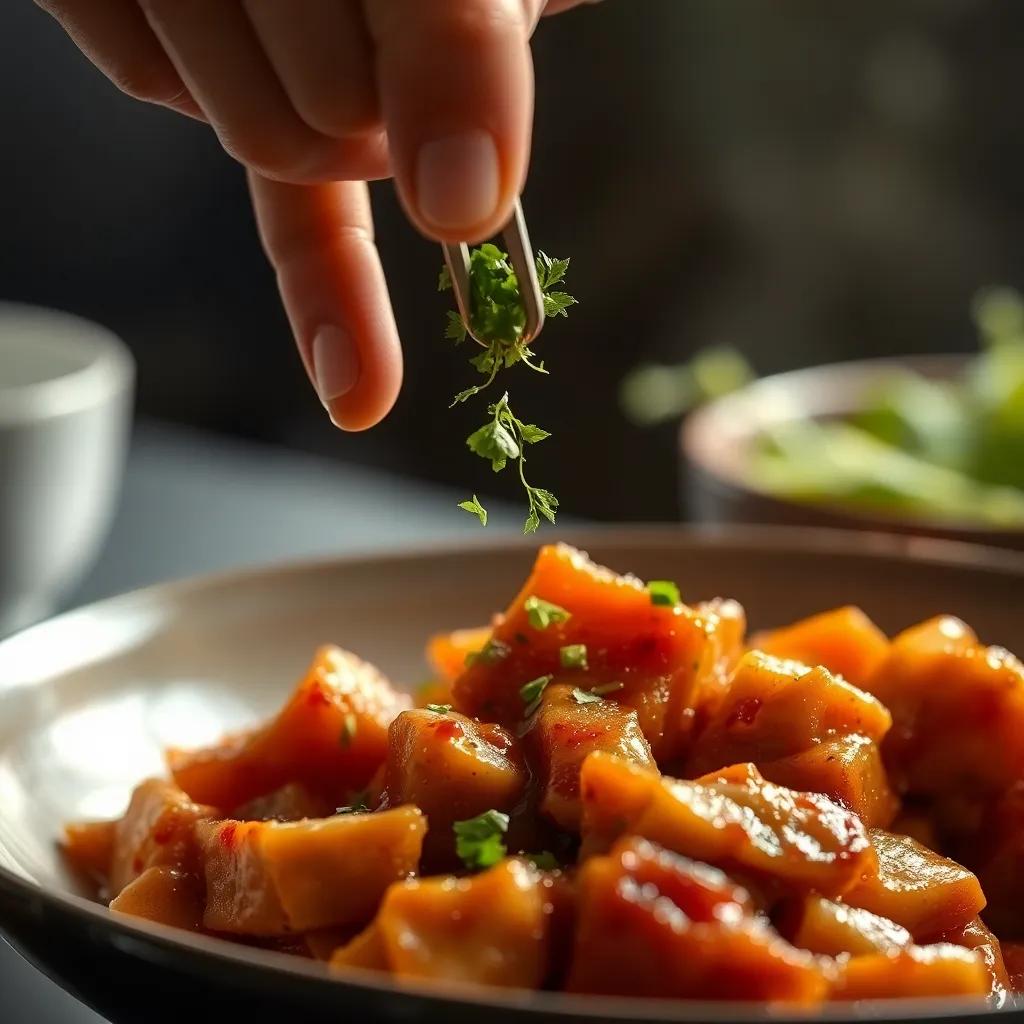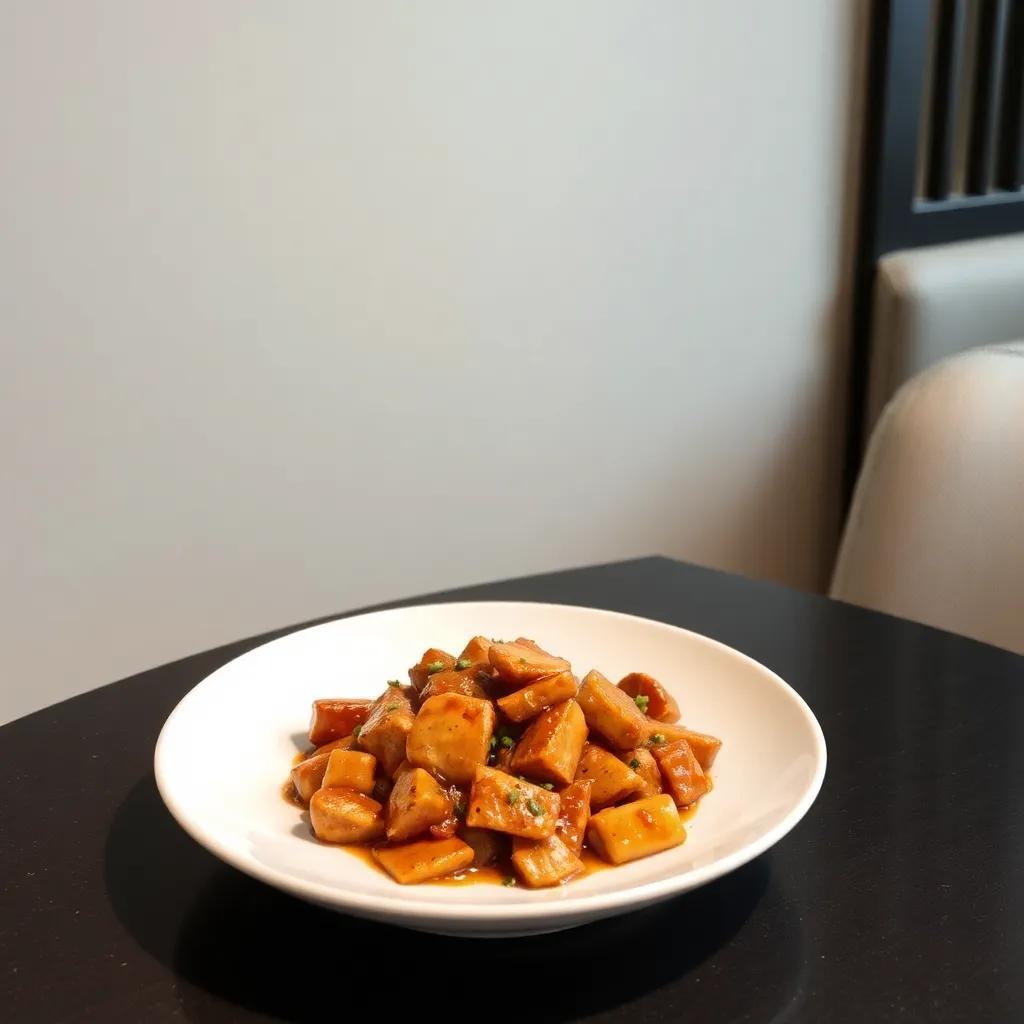Irresistible Sweet and Sour Pork Recipe: Easy, Tangy, and Crispy

Irresistible Sweet and Sour Pork Recipe: Easy, Tangy, and Crispy
🌍 Cuisine: Chinese
⚙️ Difficulty: Easy
Ingredients
Nutrition Facts
480 kcal
Instructions
- Start by cutting the pork tenderloin into bite-sized pieces. Season lightly with salt and pepper.
- Set up a breading station: place beaten eggs in one bowl and cornstarch in another.
- Dip each pork piece first into the eggs, then coat thoroughly with cornstarch. Set aside on a plate.
- Heat vegetable oil in a deep frying pan or wok over medium-high heat. When hot, fry pork pieces in batches until golden brown and crispy, about 3-4 minutes per batch. Drain on paper towels.
- In a separate bowl, mix together ketchup, rice vinegar, brown sugar, soy sauce, and 1/2 cup water to make the sweet and sour sauce.
- In a small cup, dissolve 1 tablespoon cornstarch in 2 tablespoons water for thickening the sauce.
- Remove excess oil from the pan, leaving about 1 tablespoon for sautéing vegetables. Stir fry the chopped green and red bell peppers and onion for 2-3 minutes until slightly tender but still crisp.
- Add pineapple chunks to the vegetables and stir for another minute.
- Pour the sweet and sour sauce mixture into the pan with vegetables, bring to a simmer.
- Slowly stir in the dissolved cornstarch mixture, cooking until the sauce thickens and becomes glossy.
- Add the crispy pork back into the pan and toss well to coat every piece evenly with the sauce.
- Cook everything together for an additional 2 minutes to ensure the pork absorbs the flavors.
- Remove from heat and serve immediately over steamed white rice or noodles.
Serving Suggestions
- Serve with steamed jasmine rice for a classic pairing.
- Accompany with stir-fried bok choy or broccoli for added greens.
- Pair with egg fried rice or vegetable fried rice for extra flavor.
- Garnish with sesame seeds or sliced green onions for color and texture.
- Enjoy with a side of hot and sour soup to complete the meal.
- Offer chilled Asian-style iced tea or jasmine tea alongside.
- For a fun twist, serve as a filling in steamed bao buns or wraps.
Table of Contents

Intro
Sweet and sour pork is one of those timeless dishes that effortlessly bridges comfort and excitement in every bite. This recipe captures the perfect balance of tangy sweetness and crispy, tender meat, making it a standout at any meal without requiring hours in the kitchen. Whether you’re cooking for a casual family dinner, hosting friends for a weeknight feast, or simply craving a flavorful homemade takeout, this version delivers delight with minimal fuss.
What makes this dish truly special is how approachable it is—no need for complicated techniques or hard-to-find ingredients. The result? A vibrant plate bursting with color and texture that feels both familiar and fresh. Its combination of crispy pork pieces and lively sauce turns even a simple dinner into something to look forward to, with enough flair to impress guests without stress.
This recipe thrives in versatile settings: it’s equally at home as a quick weekday meal, a festive weekend treat, or part of a larger Asian-inspired spread. Serve it alongside steamed rice or noodles, and you’ve got a crowd-pleaser that invites sharing, savoring, and coming back for seconds.
Ingredient Notes
When it comes to crafting the perfect sweet and sour pork, a few key ingredients truly elevate the dish from ordinary to irresistible. Understanding their roles and knowing how to select or substitute them can make all the difference in your cooking experience and final flavor.
Pork Tenderloin:
This cut is prized for its tenderness and mild flavor, making it ideal for bite-sized, crispy-fried pieces. Unlike fattier cuts, pork tenderloin crisps up beautifully without becoming greasy, offering that satisfying contrast of a crispy exterior and juicy interior. When shopping, look for pork that is firm with a pale pink color and minimal marbling to ensure freshness. If tenderloin isn’t available, pork loin or shoulder can work, but be mindful these cuts may require slightly longer frying times and might not be as tender.
Cornstarch (for Breading and Sauce Thickening):
Cornstarch plays a dual role here. Its fine, powdery texture creates that coveted crispy coating on the pork when fried, sealing in moisture while providing a light crunch. Additionally, it acts as a natural thickener for the sauce, yielding a glossy, clingy finish that coats the pork and vegetables perfectly. When buying cornstarch, choose a pure, unseasoned product to avoid unwanted flavors. For gluten-free cooking, cornstarch is a great alternative to wheat-based flour. Tapioca starch or potato starch can be used as substitutes for both breading and thickening, though they may produce slightly different textures.
Rice Vinegar:
This ingredient is the sour backbone of the sauce, lending a gentle acidity that balances the sweetness and deep umami notes. Rice vinegar is milder and less sharp than other vinegars, making it perfect for sweet and sour dishes that aim for harmony rather than punchy tartness. When selecting rice vinegar, look for the unseasoned or plain variety to control the flavor balance yourself, as some brands add sugar or salt. If rice vinegar is unavailable, white wine vinegar or apple cider vinegar can fill in, but start with less and adjust to taste since they have stronger profiles.
Pineapple Chunks:
Fresh or canned, pineapple adds a burst of natural sweetness and subtle tang that complements the sauce and cuts through the richness of the fried pork. Fresh pineapple delivers vibrant texture and brightness, while canned pineapple is convenient and still imparts great flavor. Choose pineapple chunks in juice rather than syrup if using canned, to avoid excessive sweetness. If pineapple isn’t accessible or preferred, diced mango or apple pieces can be interesting alternatives that maintain the sweet-tart contrast.
By paying attention to these cornerstone ingredients and shopping mindfully, you set your sweet and sour pork up for success, ensuring each bite is layered with the textures and flavors that make this dish so delightful.
Tips & Variations
Mastering sweet and sour pork is as much about technique and personalization as it is about following the recipe. Here are some expert tips and creative twists to make this dish uniquely yours, along with easy swaps to accommodate different dietary preferences.
- Achieving Ultimate Crispiness: For that coveted crispy crust, make sure your oil is hot enough (around 350°F/175°C) before frying the pork. If the oil is too cool, the coating will absorb oil and become soggy. Also, frying the pork in small batches prevents overcrowding and keeps the temperature steady for even crisping. Double-frying your pork pieces—frying once until light golden, resting, then frying a second time until deep golden and crunchy—can elevate the texture further.
- Sauce Perfection: Balance is key in the sweet and sour sauce. Taste as you go and adjust sweetness or tanginess by adding a pinch more brown sugar or a splash more vinegar depending on your preference. If you prefer a thicker sauce, whisk an extra teaspoon of cornstarch into your water slurry. Conversely, to keep it lighter, reduce the cornstarch or strain out any excess solids after simmering.
- Vegetable Variations: While green and red bell peppers and onion are classic choices, feel free to experiment with other crisp-tender veggies like snap peas, julienned carrots, or baby corn. Adding a handful of water chestnuts can introduce a delightful crunch that contrasts beautifully with the tender pork.
- Pineapple Alternatives and Ideas: Fresh pineapple provides the best brightness, but canned is perfectly fine and more accessible. For a fun twist, try substituting pineapple with apricot halves or even peaches when in season, giving your dish a subtly different fruity note and seasonal flair.
- Gluten-Free Adjustments: This recipe is friendly to gluten-free diets if you use gluten-free soy sauce or tamari in place of regular soy sauce. Confirm your cornstarch and ketchup labels as well, since some may contain gluten additives. This swap keeps the flavor intact without compromising texture.
- Vegan Version: To enjoy a plant-based spin, substitute pork with firm tofu, tempeh, or even cauliflower florets coated in the same eggless batter—try a mixture of non-dairy milk and a little aquafaba or flax egg as a binder. Adjust frying times accordingly to get a satisfying crisp outside and tender inside. Keep the sauce ingredients, just ensure your soy sauce and ketchup are vegan-friendly.
- Adding a Spicy Kick: If you crave a bit of heat, stir in a teaspoon of chili garlic sauce, sriracha, or red pepper flakes to the sauce. This adds depth and excites the palate without overpowering the sweet and tangy harmony.
- Serving and Presentation Tips: For an elegant touch, sprinkle toasted sesame seeds or finely chopped fresh cilantro or green onions on top just before serving. This not only adds color but layers in subtle flavors and aromas.
By applying these tips and exploring variations, you can customize your sweet and sour pork to fit any occasion, dietary need, or flavor preference—transforming a simple classic into a personalized culinary delight.
Leftovers & Storage
To keep your irresistible sweet and sour pork tasting fresh and delicious beyond the first meal, proper storage and handling of leftovers are key. Since this dish features crispy fried pork coated in a glossy, tangy sauce, maintaining the right texture while ensuring safety will help you enjoy it again without disappointment.
Store any leftover sweet and sour pork in an airtight container once it has completely cooled to room temperature. Glass or BPA-free plastic containers with tight-fitting lids work best for preserving flavor and preventing moisture buildup, which can make the pork soggy. For fridge storage, try to consume leftovers within 3 to 4 days to enjoy the pork at its best quality and avoid spoilage.
If you want to keep the dish longer, sweet and sour pork freezes very well. Separate the pork and sauce mixture into freezer-safe, portioned containers or heavy-duty zip-top bags, pressing out as much air as possible. Properly stored in the freezer, it will maintain good flavor and texture for up to 2 months. Thaw overnight in the refrigerator before reheating.
When reheating, crispiness can be a challenge since the moisture from the sauce may soften the pork coating. To revive some crunch, reheat in a preheated oven or toaster oven at 350°F (175°C) for 8–10 minutes, turning halfway through. This helps evaporate excess moisture and refresh that satisfying crisp exterior. Avoid using the microwave alone, as it tends to make fried foods soggy. If needed, a quick pan sauté over medium heat can also re-crisp the pork while warming it evenly.
For meal prep or packed lunches, the sweet and sour pork holds up well when kept chilled and reheated within a day. Pack the pork and sauce combined or separately if you want to re-crisp before serving. Pair with steamed rice or noodles stored in a different compartment to keep everything fresh and prevent sogginess.
With these storage tips, you can confidently prepare a larger batch of this tangy, crispy favorite, knowing your leftovers will retain their deliciousness and texture for enjoyable second helpings—or even a quick, flavorful meal on a busy day.
Behind the Recipe
Sweet and sour pork is more than just a delicious dish; it’s a beautiful bridge between cultural tradition and home-cooked comfort. Originating from Cantonese cuisine, this iconic recipe has long represented the art of balancing bold flavors—melding the tanginess of vinegar with the sweetness of sugar and fruit, all wrapped around tender, crispy pork. Its roots trace back to southern China, where sweet and sour sauces first appeared as a way to highlight contrasting tastes, a hallmark of Chinese culinary philosophy.
For many home cooks around the world, this dish evokes memories of bustling family dinners and early takeout experiences, where its vibrant colors and harmony of flavors promise satisfaction after a long day. Personally, crafting sweet and sour pork at home rekindles that sense of celebration and togetherness. The familiar crunch of the pork, coated in a glossy sauce brushed with pineapple’s bright sweetness, brings a comforting nostalgia—yet still offers plenty of room for creative flair.
What makes this recipe particularly special is its accessibility without sacrificing authenticity. It honors the classic flavor profile while embracing straightforward techniques that anyone can master. This ensures that whether you’re a seasoned cook or a beginner eager to explore Chinese flavors, you’re invited to enjoy a dish that has crossed oceans and generations, landing comfortably on your dinner table.
In exploring sweet and sour pork, we’re celebrating a dish that balances contrast and unity—crispy meets tender, sweet meets tart—in a way that mirrors the culinary storytelling that food does best. It’s a recipe with history, heart, and endless appeal.
FAQ
Can I use chicken or tofu instead of pork in this recipe?
What’s the best way to keep the pork crispy after mixing with the sauce?
How can I make this dish a bit healthier without losing flavor?
Can I prepare this recipe ahead of time and store leftovers?
Is it okay to freeze sweet and sour pork, and how should I do it?
What can I use if I don’t have rice vinegar for the sauce?
Can I adjust the sweetness and tanginess to suit different tastes?
Enjoy Your Meal!
There’s something truly comforting about the perfect balance of tangy sweetness and crispy pork that makes this Sweet and Sour Pork recipe so irresistible. Whether you’re cooking for family, friends, or just treating yourself, it’s a dish that brings a delightful burst of flavor with every bite—simple enough for any home cook but impressive enough to share.
We’d love to hear how your batch turns out! Feel free to leave a comment, rate the recipe, or share your own creative twists. After all, the best meals are the ones made memorable by your personal touch. Happy cooking!












